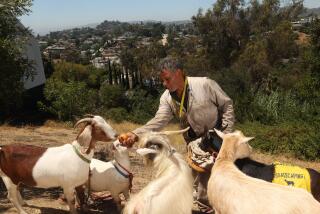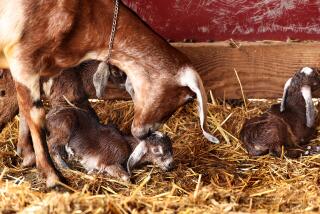Animal Lovers Helping Save San Clemente Island Goats : Scores Adopt Homeless ‘Kids’ From Overseas
ESCONDIDO, Calif. — Granted, not everyone has it in his blood to adopt a homeless kid from overseas.
That’s probably one of the few things--maybe the only thing--in common between Betty Ahrensberg, a Spring Valley, Calif., tax return preparer, and Leonard Johnson, a car dealer in Edna, Tex.
The two, along with scores of others in California, Texas and elsewhere, have found themselves caught up in the campaign to adopt the hundreds of Andalusian goats that have been rescued by the Fund for Animals over the last three years from San Clemente Island, 60 miles off San Diego’s coastline.
Johnson picked up his pair of goats last September and, with the marketing savvy of a car salesman, added them to the collection of barnyard animals that populate his two-acre petting zoo behind his Buick-Pontiac-AMC dealership 100 miles west of Houston. After all, there’s nothing like keeping the children happily occupied while closing a deal with mom and dad.
No Animal Newcomer
Ahrensberg is a more recent goat adopter, having picked up a pair of young nannies last weekend from the Animal Trust Sanctuary in Ramona, east of here. While she’s no newcomer to animals--her son is active in the 4-H program--Ahrensberg says she felt no burning desire to go out and collect any more animals.
But she admits that she was touched by the plight of San Clemente Island’s infamous wild goats, which are blamed by the Navy for destroying island habitat that is essential for the survival of endangered plants and animals. Since the goats are not endangered, they drew the short straw in the question of who or what was most expendable in the island’s battle for survival.
The original goats were dropped off on the island more than 200 years ago by sailors to provide food for their passing brethren, and at one point the herd numbered 30,000, biologists estimate. Since the early 1970s, all but the 1,200 to 1,500 now on the island have been shot or trapped and removed.
The Navy wants them off, once and for all, and the international Fund for Animals, which has trapped and removed about 1,000 goats from the island in the last two years, was given until March to capture as many as possible before marksmen begin a wholesale goat shoot. So far, about 420 goats have been taken off the island.
‘Thought I Was Crazy’
The Ahrensberg family already owns a dog, a cockateel, a sheep and a milking goat, “And my husband thought I was kind of crazy, going out in the rain to get two more goats,” Ahrensberg said. “And my neighbors say I’m the only one they know who would get a pair of goats that I can’t even show (in 4-H competition).
“But they’re such self-sufficient and wonderful-looking animals. With their horns, they remind me a little of deer.”
So, she laid down a blanket in the back of her station wagon, put down a layer of oat hay and drove to Ramona to pick out two young nannies.
The goats don’t seem to be suffering for the experience, she said. Not only do they have the run of three acres, but she and her husband stacked a bunch of railroad ties, “like Tinker Toys,” for the goats to climb on and hide beneath.
‘Everybody Comes to Visit’
“They went to it instantly,” she said. “They jump on and off, and play on it all day long. Everybody comes to visit our own little wild animal park and our San Clemente goats.”
The Ahrensbergs, of course, are not alone in their fondness for the little brown and black critters.
Karen and David Sheldon adopted two young nannies to go with their African Pygmy goat, a wild burro, five dogs, a rabbit, a chinchilla, a mouse and two horses--on their one-third acre of property in Bonita, south of San Diego.
“I love them,” Karen Sheldon said of her newest boarders. “They follow me around, and they ‘baaah’ when I go out in the backyard.”
Warning of Stress
There is some disagreement about the wisdom of adopting the wild goats and transplanting them into a backyard setting. Dr. Patrick Ryan, a public health veterinarian for the County of Los Angeles, warns that the goats might suffer from stress in close quarters because they are not familiar with enclosures.
Such stress, he said, could lead to medical problems.
He also notes that since the goats lived in a relatively germ-free environment, they might be susceptible to illnesses and parasites that are more common on the mainland.
And Ryan suggests that unless the goat is less than a year old, it may not socialize well with humans. “It’s like taking a tiger out of the jungle,” he said. “Wild animals are trained to think totally different than domestic animals. If they didn’t, they wouldn’t have survived in the wild. So people might be in for disappointment if they hope a mature goat will be a pet for their children.”
Quick to Adapt
But people who have adopted mature goats say they were surprised how quickly the goats showed signs of affection to their new owners.
The Fund for Animals operates a 600-acre ranch at Murchison, Tex., 75 miles east of Dallas, where 600 goats were taken last year after being captured on San Clemente Island. About 250 of them have since found permanent homes in Texas, including the two goats taken by Kenneth Grace, who lives in nearby Tyler.
“I promised my two kids (boys, ages 3 and 5) goats for Christmas if they were good, so the day after Christmas we went out and picked up two,” Grace said. “One of them is fixing to have a baby, and we’re looking forward to that.
“Every morning, my boys go out and feed them and they (the goats) have been just fine toward them. They don’t like the dogs too much and they’ll chase them, but now the dogs chase them back, and I think it’s gotten to be a game between them.”
Goats Eat Brush
Harold Currin, who owns a plumbing and electrical supply company in Athens, Tex., adopted 102 goats last June to eat the brush on the 300 acres of ranch land he owns.
“I don’t do anything with them,” Currin said. “They’re just out there, eating the brush that the cattle won’t eat. And I hear there’s another herd of the goats over at the Boy Scout reservation down the highway.
“We’ve had quite a few babies since we got the goats. They’re gentle animals. They come right up to us when we put hay out for them.”






